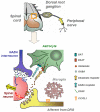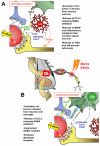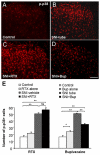Glial cells and chronic pain
- PMID: 20581331
- PMCID: PMC3017463
- DOI: 10.1177/1073858409360822
Glial cells and chronic pain
Abstract
Over the past few years, the control of pain exerted by glial cells has emerged as a promising target against pathological pain. Indeed, changes in glial phenotypes have been reported throughout the entire nociceptive pathway, from peripheral nerves to higher integrative brain regions, and pharmacological inhibition of such glial reactions reduces the manifestation of pain in animal models. This complex interplay between glia and neurons relies on various mechanisms depending both on glial cell types considered (astrocytes, microglia, satellite cells, or Schwann cells), the anatomical location of the regulatory process (peripheral nerve, spinal cord, or brain), and the nature of the chronic pain paradigm. Intracellularly, recent advances have pointed to the activation of specific cascades, such as mitogen-associated protein kinases (MAPKs) in the underlying processes behind glial activation. In addition, given the large number of functions accomplished by glial cells, various mechanisms might sensitize nociceptive neurons including a release of pronociceptive cytokines and neurotrophins or changes in neurotransmitter-scavenging capacity. The authors review the conceptual advances made in the recent years about the implication of central and peripheral glia in animal models of chronic pain and discuss the possibility to translate it into human therapies in the future.
Figures





References
-
- Brisby H, Olmarker K, Rosengren L, Cederlund CG, Rydevik B. Markers of nerve tissue injury in the cerebrospinal fluid in patients with lumbar disc herniation and sciatica. Spine. 1999;24(8):742–6. - PubMed
-
- Chang YW, Tan A, Saab C, Waxman S. Unilateral Focal Burn Injury Is Followed by Long-Lasting Bilateral Allodynia and Neuronal Hyperexcitability in Spinal Cord Dorsal Horn. J Pain. 2009 - PubMed
-
- Chudler EH, Anderson LC, Byers MR. Trigeminal ganglion neuronal activity and glial fibrillary acidic protein immunoreactivity after inferior alveolar nerve crush in the adult rat. Pain. 1997;73(2):141–9. - PubMed
-
- Clark AK, Gentry C, Bradbury EJ, McMahon SB, Malcangio M. Role of spinal microglia in rat models of peripheral nerve injury and inflammation. Eur J Pain. 2007;11(2):223–30. - PubMed
Publication types
MeSH terms
Grants and funding
LinkOut - more resources
Full Text Sources
Medical
Miscellaneous

